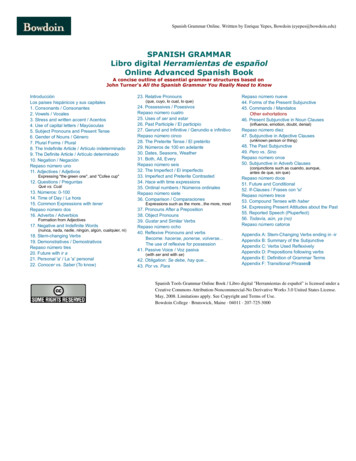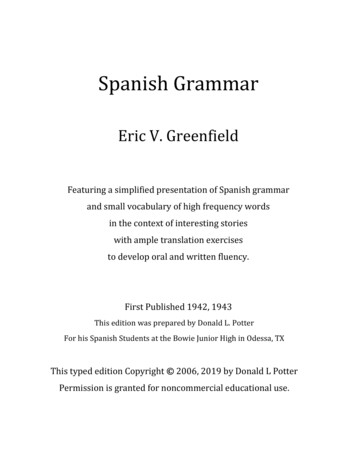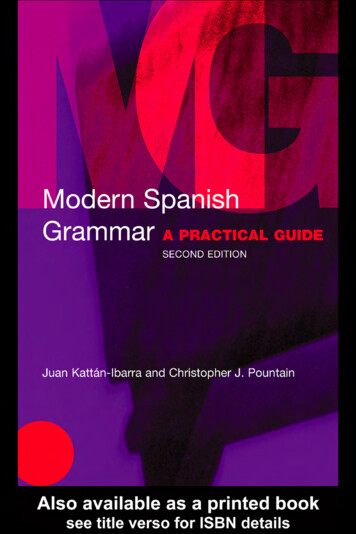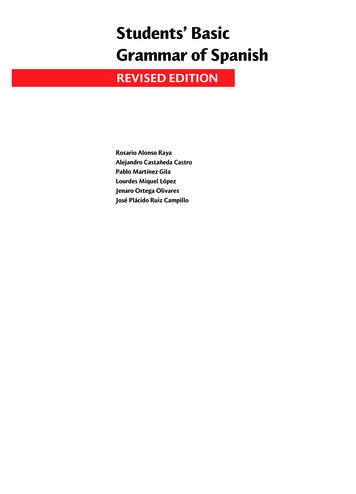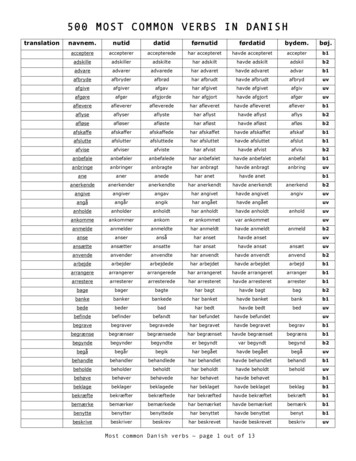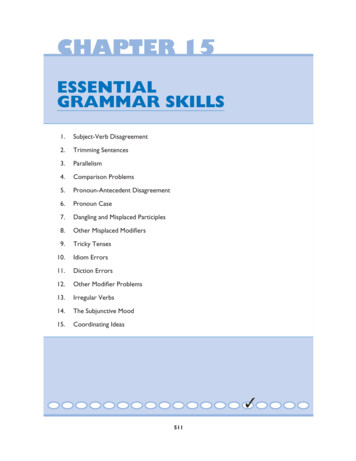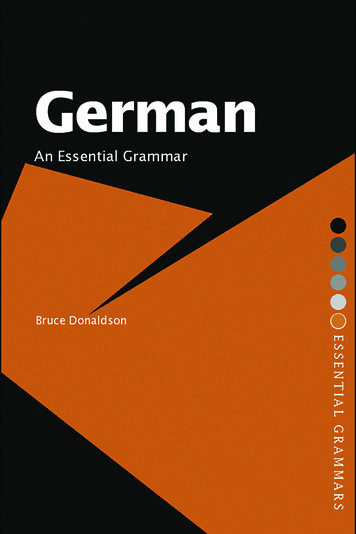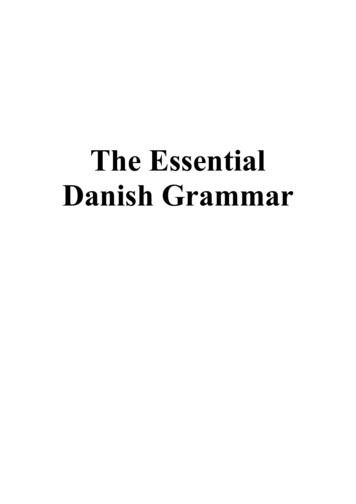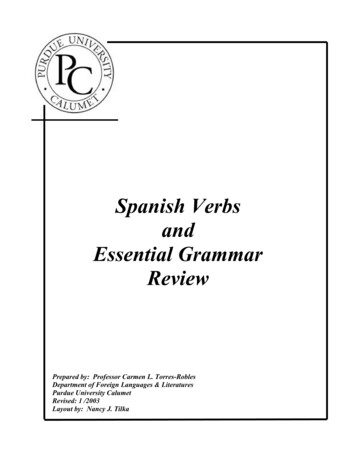
Transcription
Spanish VerbsandEssential GrammarReviewPrepared by: Professor Carmen L. Torres-RoblesDepartment of Foreign Languages & LiteraturesPurdue University CalumetRevised: 1 /2003Layout by: Nancy J. Tilka
CONTENTSSpanish VerbsIntroductionIndicative Mood45 simple & compound tenses: present, past, future, conditionalSubjunctive Mood12 simple & compound tenses: present, pastSer / Estar16Essential GrammarPronounsPossesive Adjectives and PronounsPrepositional PronounsPor versus ParaComparisons / SuperlativesPreterite / ImperfectSubjunctive MoodCommandsPassive Voice2023252731343742462
Spanish Verbs3
INTRODUCTIONVERBS (VERBOS)MOODS (MODOS)There are three moods or ways to express verbs (actions) in Spanish.1. Indicative Mood (objective)2. Subjunctive Mood (subjective)3. Imperative Mood (commands)INFINITIVES (INFINITIVOS)A verb in the purest form (without a noun or subject pronoun to perform the action) is called aninfinitive. The infinitives in English are characterized by the prefix “to” “verb form”, the Spanishinfinitives are identified by the “r” ending.Exampleestudiar, comer, dormirto study, to eat, to sleepCONJUGATIONS (CONJUGACIONES)Spanish verbs are grouped in three categories or conjugations.1. Infinitives ending in –ar belong to the first conjugation.2. Infinitives ending in –er belong to the second conjugation.3. Infinitives ending in –ir belong to the third conjugation.(estudiar)(comer)(dormir)VERB STRUCTURE (ESTRUCTURA VERBAL)Spanish verbs are divided into three parts. (infinitive: estudiar)1. Stem or Root2. Theme Vowel3. "R" Ending(estudi-)(-a-)(-r)CONJUGATED VERBS (VERBOS CONJUGADOS)To conjugate a verb, a verb must have an explicit subject noun (ex: María), a subject pronoun (yo, tú,usted, él, ella, nosotros(as), vosotros(as), ustedes, ellos, ellas), or an implicit subject, to indicate theperformer of the action.*ATTENTION*Subject pronouns are not used as frequently in Spanish as in English. They are used mainly foremphasis or clarification in Spanish since the ending of the conjugated verb often indicates the subjectperforming the action.TENSES (TIEMPOS)Actions (verbs) can be expressed either in the present, past, future, or conditional tenses. They appearin either simple or compound forms.REGULAR/IRREGULAR VERBS (VERBOS REGULARES/IRREGULARES)Verbs that do not require changes in their stems are considered regular. Verbs requiring spelling orstem changes are considered irregular.4
INDICATIVE MOOD(SIMPLE TENSES)PRESENT TENSEREGULAR VERBSThe present tense endings for regular verbs are as follows:-ar conjugation-o-amos-as-áis-a-anhablar (to speak)hablohablamoshablashabláishablahablan-er conjugation-o-emos-es-éis-e-encomer (to eat)comocomemoscomescoméiscomecomenIRREGULAR VERBS1. Irregular “yo” FormThe verbs listed below are irregular only in the yo form.Exampleinfinitivehacer (to make; to do)poner (to put)traer (to bring)salir (to leave; to go out)valer (to be worth)caer (to ucir z co(to know)(to disappear)(to obey)(to produce)(to drive)(to translate)Exampleinfinitivedistinguir(to distinguish)gu fi godistingoExampleinfinitiveconvencer (to convince)cer fi zoconvenzo5-ir conjugation-o-imos-es-ís-e-envivovivesvivevivir (to live)vivimosvivísviven
Exampleinfinitivecoger (to pick, take)escoger (to choose)proteger (to protect)dirigir (to manage)exigir (to demand)g fi jocojoescojoprotejodirijoexijo2. Stem-Changing VerbsThe following verbs are irregular in the stem when conjugated, except* in the nosotros and vosotrosforms.Examplee fi iecerrar (to o fi uedormir (to sleep)duermoduermesduermedormimos*dormís*duermene fi ipedir (to ask)pidopidespidepedimos*pedís*piden3. Irregular "yo" Forms Stem-ChangingThe following verbs are irregular in the yo form and irregular in the stem when conjugated except*in the nosotros and vosotros forms.Example-go stem changetener (to have)venir (to come)decir (to tell; to say)conseguir (to get; to obtain)tengo / tienes / tiene / tenemos* / tenéis* / tienenvengo / vienes / viene / venimos* / venís* / vienendigo / dices / dice / decimos* / decís* / dicenconsigo / consigues / consigue / conseguimos* /conseguís* / consiguen4. Jugar (to play)This verb behaves like a stem-changing verb. An –e must be inserted except* in the nosotros andvosotros forms.Examplejuego / juegas / juega / jugamos* / jugáis* / juegan5. Distribuir (to distribute)To avoid the presence of three vowels in a row, this verb requires the –ui to change to –uy, except*in the nosotros and vosotros forms. Other similar verbs also follow this pattern.Exampledistribuyo / distribuyes / distribuye /distribuimos* / distribuís* / distribuyen6
OTHER IRREGULAR VERBS serestarirdarolerhaber(to be)(to be)(to go)(to give)(to smell)(aux verb to have)soy / eres / es / somos / sois / sonestoy / estás / está / estamos / estáis / estánvoy / vas /va / vamos / vais / vandoy / das / da / damos / dais / danhuelo / hueles / huele / olemos / oléis / huelenhe / has / ha / hemos / habéis / hanPAST TENSESSpanish has two simple past tenses, the imperfect and the preterite.IMPERFECT TENSE: REGULAR VERBSThe imperfect endings for regular verbs are as follows:-ar conjugations-aba -ábamos-abas -ábais-aba -aban-er conjugations-ía-íamos-ías -íais-ía-ían-ir conjugations-ía-íamos-ías asvivíavivíamosvivíaisvivíanIMPERFECT TENSE: IRREGULAR VERBSThere are only three irregular verbs in the imperfect eían*ATTENTION*There are no stem-changing verbs in the imperfect tense.PRETERITE TENSE: REGULAR VERBSThe preterite tense endings for regular verbs are as follows:-ar conjugations-é-amos-aste -asteis-ó-aroncantar-er conjugations-í-imos-iste -isteis-ió-ieron-ir conjugations-í-imos-iste -isteis-ió-ieroncomervivir7
vivióvivimosvivisteisvivieronPRETERITE TENSE: IRREGULAR VERBS1. Spelling-ChangingVerbs. -ar verbs with irregular yo lleguécempecé -er verbs with irregular third person singular and plural formsExamplecaer ficreer fileer ficayó / cayeroncreyó / creyeronleyó / leyeron -ir verbs with irregular third person singular and plural formsExampleoírfioyó / oyeron2. Stem-Changing Verbs. This change only occurs with certain –ir verbs in the third person singularand plural forms. There are no stem-changing –ar or –er verbs.Exampleefipedirofidormiripidió / pidieronudurmió / durmieronPRETERITE TENSE: IRREGULAR VERBS (IRREGULAR ENDINGS)Certain -ar / -er / -ir verbs are irregular in the stem and also have the following irregular endings:-e-iste-o-imos-isteis-ieron / -eron1. -uv- / -u- in the stemExampleandar anduve / anduviste / anduvo / anduvimos / anduvisteis / anduvieronestar estuve / estuviste / estuvo / estuvimos / estuvisteis / estuvierontenerhabertuve / tuviste / tuvo / tuvimos / tuvisteis / tuvieronhube / hubiste / hubo / hubimos / hubisteis / hubieron8
poderponersaberpude / pudiste / pudo / pudimos / pudisteis / pudieronpuse / pusiste / puso / pusimos / pusisteis / pusieronsupe / supiste / supo / supimos / supisteis / supieronquerervenirquise / quisiste / quiso / quisimos / quisisteis / quisieronvine / viniste / vino / vinimos / vinisteis / vinieron2. -i- in the stemExample3. -i- in the stem c fi z (third person singular)Examplehacerhice / hiciste / hizo / hicimos / hicisteis / hicieron4. -j- in the stem ieron fi eron (third person plural)Exampledecirproducirtraerdije / dijiste / dijo / dijimos / dijisteis / dijeronproduje / produjiste / produjo /produjimos / produjisteis / produjerontraje / trajiste / trajo / trajimos / trajisteis / trajeron(For uses of the imperfect and preterite, see pages 30-32.)FUTURE TENSEThe future tense corresponds to the English will or shall.REGULAR VERBSThe future tense endings for regular verbs are formed by adding the endings below to the infinitive.-é-ás-á-ar aréisestudiaráestudiarán-emos-éis-án-er comerán-ir �viviránIRREGULAR VERBS (ONLY IN THE STEM)These verbs use the regular future endings, however there is a change in the stem before adding theendings.poner fi pondrpoder fi podrsalir fi saldrtener fi tendrvaler fi valdrvenir fi vendrsaber fi sabrhaber fi habrquerer fi querrhacer fi hardecir fi dir-9
CONDITIONAL TENSEThe conditional tense corresponds to the English would.REGULAR VERBSLike the future tense, the conditional tense is formed by adding the conditional endings below to theinfinitive.-ía-ías-ía-ar an-er omeríacomerían-ie iviríaviviríanIRREGULAR VERBS (ONLY IN THE STEM)All verbs considered irregular in the future tense, are also considered irregular in the conditional tense.Remember to use the conditional endings. The irregular stems are the same as in the future tense.(COMPOUND TENSES)Compound tenses are formed with the appropriate conjugated form of the auxiliary verb haber(to have) past participle (regular or irregular form).REGULAR PAST PARTICIPLESTo form regular past participles of –ar conjugations, add the ending –ado to the stem. For –er and –irconjugations, add the ending –ido to the stem.Exampleestudiarcomervivirfififiestudiado (studied)comido (eaten)vivido (lived)IRREGULAR PAST PARTICIPLESThere are no irregular past participles for –ar conjugation verbs. The following –er and –ir verbs haveirregular past participles.-er conjugationpast participle-ir conjugationpast participleenvolverenvuelto (wrapped)abrirabierto (opened)devolverdevuelto (returned: things) cubrircubierto (covered)hacerhecho (done)decirdicho (said)ponerpuesto (placed)descubrirdescubierto (discovered)romperroto (broken)morirmuerto (dead)resolverresuelto (resolved)escribirescrito (written)vervisto (seen)volvervuelto (returned)10
PRESENT PERFECT TENSEThe present perfect tense is formed by using the present tense of the auxiliary verb haber (conjugatedbelow in the present indicative) past participle (regular or irregular form).hehashaExamplehaber (present tense)hemoshabéishanHe estudiado la lección.Has comido la ensalada.Ha dormido bien.Hemos escrito la carta.Han hecho la tarea.I have studied the lesson.You have eaten the salad.He/She has slept well.We have written the letter.They have done the homework.PAST PERFECT TENSE (PLUPERFECT)The past perfect is formed by using the imperfect tense of the auxiliary verb haber (conjugated belowin the imperfect indicative) past participle (regular or irregular form).haber (impefect xampleHabía estudiado la lección.Habías comido la ensalada.Había dormido bien.Habíamos escrito la carta.Habían hecho la tarea.I/He/She had studied the lesson.You had eaten the salad.I/He/She had slept well.We had written the letter.They had done the homework.FUTURE PERFECT TENSEThe future perfect is formed by using the future tense of the auxiliary verb haber (conjugated below inthe future indicative) past participle (regular or irregular form).haber (future bránHabré estudiado la lección.Habrás comido la ensalada.Habrá dormido bien.Habremos escrito la carta.Habrán hecho la tarea.I will have studied the lesson.You will have eaten the salad.He/She will have slept well.We will have written the letter.They will have done the homework.11
CONDITIONAL PERFECT TENSEThe conditional perfect is formed by using the conditional tense of the auxiliary verb haber (conjugatedbelow in the conditional tense) past participle (regular or irregular form).haber (conditional ríanExampleHabría estudiado la lección.Habrías comido la ensalada.Habría dormido bien.Habríamos escrito la carta.Habrían hecho la tarea.I/He/She would have studied the lesson.You would have eaten the salad.I/He/She would have slept well.We would have written the letter.They would have done the homework.SUBJUNCTIVE MOOD(SIMPLE TENSES)PRESENT TENSEThe present tense of the subjunctive mood is equivalent to the English auxiliary verb may.REGULAR VERBSThe present tense endings for regular verbs in the subjunctive mood are as follows:ar diemosestudiesestudiéisestudieestudien-er conjugation-a-amos-as-áis-a-an-ir vivanIRREGULAR VERBS1. Verbs with an irregular “yo” form in the present indicative are not only irregular in the “yo” form ofthe subjunctive, but in all forms of the present subjunctive tense.Exampleinfinitivegahacer (to make; to do) haga / hagas / haga / hagamos / hagáis / haganponer (to put)ponga / pongas / ponga / pongamos / pongáis / pongantraer (to bring)traiga / traigas / traiga / traigamos / traigáis / traigan12
Examplesalir (to leave; to go out)valer (to be worth)caer (to fall)salga / salgas / salga / salgamos / salgáis / salganvalga / valgas / valga / valgamos / valgáis / valgancaiga / caigas / caiga / caigamos / caigáis / caiganinfinitiveconocer (to know)cer/cir fi z caconozca / conozcas / conozca / conozcamos /conozcáis / conozcandesaparezca / desaparezcas / desaparezca /desaparezcamos / desaparezcáis / desaparezcanobedezca / obedezcas / obedezca / obedezcamos /obedezcáis / obedezcanproduzca / produzcas / produzca / produzcamos /produzcáis / produzcanconduzca / conduzcas / conduzca / conduzamos /conduzcáis / conduzcantraduzca / traduzcas / traduzca / traduzcamostraduzcáis / / traduzcandesaparecer (to disappear)obedecer (to obey)producir (to produce)conducir (to drive)traducir (to translate)Exampleinfinitivedistinguir(to distinguish)gu fi gadistinga / distingas / distinga / distingamos /distingáis / distinganExampleinfinitiveconvencer (to convince)cer fi zaconvenza / convenzas / convenza / convenzamos /convenzáis / convenzanExampleinfinitivecoger (to pick, take)escoger (to choose)ger/gir fi jacoja / cojas / coja / cojamos / cojáis / cojanescoja / escojas / escoja / escojamos / escojáis /escojanproteja / protejas / proteja / protejamos / protejáis /protejandirija / dirijas / dirija / dirijamos / dirijáis / dirijanexija / exijas / exija / exijáis / exijamos / exijanproteger (to protect)dirigir (to manage)exigir (to demand)2. Verbs with an irregular “yo” form in the preterite tense are not only irregular in the “yo” form ofthe subjunctive, but in all forms of the present subjunctive tense.Exampleinfinitivebuscarc fi qubusque / busques / busque / busquemos / busquéis /busquenExampleinfinitivellegarg fi gullegue/ llegues / llegue / lleguemos / lleguéis /lleguenExampleinfinitiveabrazarz fi cabrace / abraces / abrace / abracemos / abracéis / abracen13
Exampleinfinitiveaveriguargu fi güaverigüe / averigües / averigüe / averigüemos /averigüéis / averigüen3. Stem Changing Verbs Verbs, which are stem changing verbs in the present indicative for –ar and –er conjugations, are alsostem changing in the present subjunctive, except* in the nosotros and vosotros forms.Exampleinfinitivecerrare fi iecierre / cierres / cierre / cerremos*/ cerréis*/cierrenExampleinfinitivevolvero fi uevuelva / vuelvas / vuelva / volvamos*/ volváis* /vuelvan Verbs, which are stem changing in the present indicative for -ir conjugations are also stem changingin the present subjunctive. The nosotros and vosotros require* the following change:Exampleinfinitivedormiro fi uduerma / duermas / duerma / durmamos*/durmáis*/ duermanExampleinfinitivesentire fi isienta / sientas / sienta / sintamos*/ sintáis*/sientanExampleinfinitivepedire fi i (all forms, including nosotros and vosotros)pida / pidas / pida / pidamos*/ pidáis*/ pidanPAST SUBJUNCTIVE TENSE (IMPERFECT)The past imperfect is formed by using the third person plural of the preterite tense (indicative mood).Drop the ending -ron from the preterite (third person plural), and add the endings below: Nosotros andvosotros forms must have a written accent over the vowel preceding the ending.-ra-ras-raestudiar fi studiáraisestudiaraestudiaran-ramos-rais-rancomer fi omieracomieran14vivir fi ivieravivieran
(COMPOUND TENSES)Compound tenses in the subjunctive mood are formed with the appropriate conjugated form of theauxiliary verb haber (to have) past participle (regular or irregular form).PRESENT PERFECTThe present perfect tense is formed by using the present subjunctive of the auxiliary verb haber(conjugated below in the present subjunctive) past participle (regular or irregular).haber anHaya estudiado la lección.Hayas comido la ensalada.Haya dormido bien.Hayamos escrito la carta.Hayan hecho la tarea.I/He/She may have studied the lesson.You may have eaten the salad.I/He/She may have slept well.We may have written the letter.They may have done the homework.PAST PERFECTThe past perfect tense is formed by using the past subjunctive (imperfect) of the auxiliary verb haber(conjugated below in the past subjunctive) past participle (regular or irregular).haber (subjunctive)hubierahubierashubieraExampleHubiera estudiado la lección.Hubieras comido la ensalada.Hubiera dormido bien.Hubierámos escrito la carta.Hubieran hecho la tarea.hubiéramoshubiéraishubieranI/He/She might have studied the lesson.You might have eaten the salad.I/He/She might have slept well.We might have written the letter.They might have done the homework.(For uses of the subjunctive mood, see pages 33-37.)15
SER(TO BE)yotúél, ella, Ud.soyeresesnosostros(as)vosotros(asellos, ellas, Uds.somossoissonUSES OF SER Ser is used to identify people and things.ExampleLuis es estudiante.Es un libro.Luis is a student.It is a book. Ser is used to express nationality. Ser with de (from) is used to express national origin.ExampleJuan es peruano.Juan es de Perú.Juan is Peruvian.Juan is from Peru. Ser with de is used to tell of what material something is made.ExampleLa mesa es de madera.The table is made of wood. Ser with para is used to tell for whom something is intended.ExampleLa comida es para Andrés.The meal is for Andrés. Ser is used to tell time.ExampleEs la una.Son las dos.It is one o'clock.It is two o'clock. The third person singular of ser is used to express generalizations.ExampleEs importante estudiar.It's important to study. Ser is used to tell where and when an event takes place.ExampleLa fiesta es en la cafetería.La fiesta es a las siete de la noche.The party is in the cafeteria.The party is at seven o'clock. Ser is used with adjectives* that describe the fundamental qualities of a person, place, or thing.It describes basic, inherent characteristics.ExampleEsteban es un hombre inteligente.16Esteban is an intelligent man.
ESTAR(TO BE)yotúél, ella, Ud.estoyestásestánosotros(as)vosotros(as)ellos, ellas, Uds.estamosestáisestánUSES OF ESTAR Estar is used to tell the location of something.ExampleEl libro está en la mesa.Juan está en España.The book is on the table.Juan is in Spain. Estar is used to form the progressive tense. In Spanish the progressive tense is formed using theverb estar plus the present participle. (The present participle is formed by adding ando to the stemof -ar verbs and iendo to the stem of -er and -ir verbs. The present participle always ends in -o.)ExampleLos alumnos están estudiando.Ellos están comiendo.The students are studying.They are eating. Estar is used to describe health.ExampleMaría está enferma.María is sick. Estar is used in a number of fixed expressions.ExampleEstoy de acuerdo con ellos.Está bien.Está claro.I am in agreement with them.It is okay.It's clear. Estar is used with adjectives* that describe conditions or states subject to change.ExampleEstoy muy aburrida.El agua está caliente.I am very bored.The water is hot.*ATTENTION*17
(SER AND ESTAR)The following adjective change their meanings based on the use of ser and estar.(Adjectivos que cambian de sentido con ser o appy (temperament)feeling y (person)illgrandebigbig for one's ageguapohandsomelooking goodlistocleverreadylococrazy (person)foolishmaduromatureripemalobadillricorich ripevivolivelyalive18
EssentialGrammar19
PRONOUNSDIRECT OBJECT PRONOUNSmetelolanososloslasUSES OF DIRECT OBJECT PRONOUNSDirect object pronouns are used when a person or thing receives the action of the verb directly. Thesepronouns answer the question what? or who? in relation to the subject and verb.ExampleCarlos escribe una carta.Carlos la escribe.Carlos writes a letter. (what?--a letter)Carlos writes it.INDIRECT OBJECT PRONOUNSmetelenososlesUSES OF INDIRECT OBJECT PRONOUNSIndirect object pronouns are used when a person (or sometimes an animal) receives the action of theverb indirectly. These pronouns usually answer the question to whom? or for whom? in relation to theverb.ExampleCarlos me escribe una carta.Carlos writes a letter to me.(to whom?--to me)REFLEXIVE PRONOUNSmetesenososseUSES OF REFLEXIVE PRONOUNSReflexive pronouns are used whenever the subject (singular or plural) does anything to or forhim/her/itself. It corresponds to the English forms: myself, yourself, himself, herself, ourselves, orthemselves. Any transitive verb, a verb that can take an object (direct or indirect), can be usedreflexively. Reflexive verbs always have se attached to the infinitive.Examplelavarseto wash oneself20
POSITION OF PRONOUNSWITH ONE CONJUGATED VERBIn statements or questions with one conjugated verb, the pronoun is placed before the conjugated verb.ExampleTengo la revista.La tengo.¿Quién tiene la revista?¿Quién la tiene?I have the magazine.I have it.Who has the magazine?Who has it? In negative commands the pronoun is placed directly before the conjugated verb. (Don't forget thatno is always part of the negative command form.)ExampleNo comas los caramelos.No los comas.Don't eat the candies.Don't eat them. In formal or informal affirmative reflexive commands, the pronoun is placed after the conjugatedverb.Exampleponerse el abrigoPóngase el abrigo.Ponte el abrigo.to put on your coat (yourself)Put on (yourself) your coat. (formal)Put on (yourself) your coat. (informal) In formal or informal negative reflexive commands, the pronoun is placed after the conjugatedverb. (Don't forget the no is always part of the negative command form.)Exampleno ponerse el abrigoNo se ponga el abrigo.No te pongas el abrigo.to not put on you coat (yourself)Don't put on (yourself) your coat. (formal)Don't put on (yourself) your coat. (informal)WITH MORE THAN ONE VERBWhen there is more than one verb in a sentence, two different positions are possible for the pronoun.The pronoun may come directly before the conjugated verb, or attached to the end of the infinitive,progressive, or reflexive forms. ir a infinitiveExampleVoy a comprar el libro.Lo voy a comprar. (directly before)Voy a comprarlo. (attached to the end)I am going to buy the book.I am going to buy it.I am going to buy it. ando / iendo (progressive construction: simple or compound tenses)*A written accent is required when attaching a pronoun to the end of the progressive or the reflexiveform.ExampleEstoy mirando las revistas.I am looking at the magazines.Las estoy mirando (directly before) I am looking at them.21
Estoy mirándolas. (attached to the end)He estado mirando las revistas.I am looking at them.I have been looking atthe magazines.Las he estado mirando. (directly before)I have been looking at them.He estado mirándolas. (attached to the end) I have been looking at them. Reflexive Progressive ConstructionsExampleLuis está lavándose las manos.Luis is washing (himself) his hands.Luis se las está lavando. (directly before) Luis is washing (himself) his hands.Luis está lavándoselas. (attached to the end) Luis is watching them. (himself) In certain impersonal expression using ser, the pronoun must be attached to the end of the infinitive.ExampleEs necesario leer el libro.Es necesario leerlo.It is necessary to read the book.It is necessary to read it.COMBINING DIRECT AND INDIRECTOBJECT PRONOUNS(DOUBLE OBJECT PRONOUNS) When two types of pronouns are combined, the indirect always comes first.ExampleCompro las flores para ti.Te las compro.I buy the flowers for you.I buy them for you. When certain combinations of pronouns that begin with the same letter occur, the indirect objectpronoun always changes to se. (example: les(s) / lo(s); le(s) / la(s))ExampleYo doy un regalo a Juan.Yo le lo doy Yo se lo doy.I give a gift to Juan.I give it to him. When two types of pronouns are combined, the two pronouns may be attached to the end of theinfinitive or progressive form, or the two pronouns may be placed before the conjugated verb. Theorder of the two pronouns cannot change regardless of the position you choose.ExampleVoy a comprar un regalo para Carmen.Se lo voy a comprar.Voy a comprárselo.I am going to buy a giftfor Carmen.I am going to buy it for her.I am going to buy it for her.Estoy comprando un libro para mi hijo.Se lo estoy comprando.Estoy comprándoselo.I am buying a book for my son.I am buying it for him.I am buying it for him.22
POSSESIVE ADJECTIVES AND PRONOUNSPossessive adjectives in Spanish have two forms, a short form (unstressed) that precedes the noun, and along form (stressed) that follows the noun.POSSESSIVE ADJECTIVES THAT PRECEDE THE NOUNThe possessive adjectives in English (my, your, his, her, and so on) do not vary in form. The possessiveadjectives in Spanish, like all adjectives in Spanish, agree in number with the noun they modify--that is,with the object possessed. The possessive adjectives nuestro and vuestro agree in gender and innumber. These forms of the possessive adjectives always precede the i carro es viejo.Mis carros son viejos.Tu carro es viejo.Tus carros son viejos.Su carro es viejo.Sus carros son viejos.Nuestro carro es viejo.Nuestros carros son viejos.Nuestra casa es vieja.Nuestras casas son viejas.Su carro es viejo.Sus carros son viejos.nuestros(as)vuestros(as)susMy car is old.My cars are old.Your car is old.Your cars are old.His/Her car is old.His/Her cars are old.Our car is old.Our cars are old.Our house is old.Our houses are old.Their car is old.Their cars are old. Since su(s) can express his, her, its, your and their, ambiguity is often avoided by using aprepositional phrase with de and a pronoun object. In this case, the definite article precedes thenoun.ExampleSu padre se sentó al lado de su madre.El padre de él se sentó al lado de la madre de ella.His father sat next to her mother.POSSESSIVE ADJECTIVES THAT FOLLOW THE NOUNThe long or emphatic (stressed) possessive adjectives are used when the speaker wishes to emphasizethe possessor rather than the thing possessed. Note that all these forms agree in both number and genderand they follow the noun.míotuyosuyoExamplemíos míatuyos tuyasuyos � es un amigo mío.nuestra(s)vuestra(s)suya(s)José is a friend of mine.23
José y Carlos son amigos míos.Carmen es una amiga mía.Carmen y María son amigas mías.José and Carlos are friends of mine.Carmen is a friend of mine.Carmen and María are friends of mine.POSSESSIVE PRONOUNSWhenever a noun is modified by an adjective or an adjective phrase, the noun can be omitted in order toavoid repetition. In such an instance, the definite article and the stressed adjective (long form) are used.ExampleMi disfraz es más impresionante que su disfraz.My costume is more impressive than his/her costume.Mi disfraz es más impresionante que el suyo.My costume is more impressive than his/hers.Mi casa es más pequeña que su casa.My house is smaller than his/her house.Mi casa es más pequeña que la suya.My house is smaller that his/hers.24
PREPOSITIONAL PRONOUNSWhen subject pronouns are used with prepositions (are objects of the prepositions), they are calledprepositional pronouns.USES OF PREPOSITIONAL PRONOUNS All subject pronouns (yo, tú, usted, él, ella, nosotros(as), vosotros(as), ustedes, ellos, ellas) remainunchanged when the following prepositions are used:como, entre, excepto, incluso, menos, salvo, segúnExampleLuis estudia como yo (como tú, como Ud., como él, como ella).Luis studies like me. (like you, like him, like her, etc.)Entre tú y yo no hay secretos.Between you and me there are no secrets. The first two subject pronouns in the singular form, yo and tú, must be changed to mí and ti whensubject pronouns are used with the prepositions below. The other subject pronouns remainunchanged.a, ante, contra, de, desde, en, hacia, hasta , para, por, sin, sobre, trasExampleMis padres desean lo mejor para mí. My parents wish the best for me.No puedo vivir sin ti.I can’t live without you.a míante mícontra míde mídesde míen míhacia míto mein front of meagainst meof mefrom inside of meabout me (of me)toward mea tiante ticontra tide tidesde tien tihacia tito youin front of youagainst youof youfrom inside of youabout (of) youtoward you When the first two subject pronouns yo and tú are used with the preposition con, the form mí, and tirequires an additional change: mí drops its accent and becomes migo; and
6 Example infinitive g fi jo coger (to pick, take) cojo escoger (to choose) escojo proteger (to protect) protejo dirigir (to manage) dirijo exigir (to demand) exijo 2. Stem-Changing Verbs The following verbs are irregular in the stem when conjugated, except* in the nosotros and vosotros forms. Example e fi ie o fi ue
